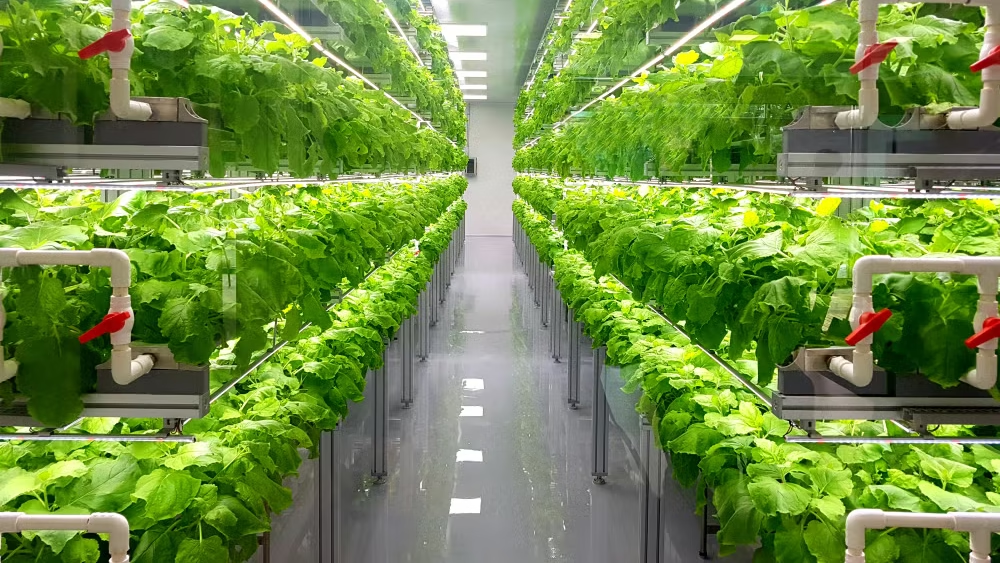Vertical farming in the UAE is changing the future of agriculture. In a region with high temperatures, little rain, and sandy soil, farming has always been a challenge. But now, with the help of technology, the UAE is growing fresh, clean, and healthy food right inside buildings.
These farms don’t need soil, sunshine, or large plots of land. Instead, they use stacked layers, LED lights, smart sensors, and very little water. This method of farming is not only clean and safe—it’s also perfect for a country like the UAE.
What exactly is vertical farming?
Vertical farming is a way of growing crops in layers that are stacked on top of each other, usually indoors. These farms use special systems like hydroponics or aeroponics, where plants grow with their roots in water or mist instead of soil.

Everything—from the temperature to the amount of light and water—is carefully controlled using technology. This helps the plants grow faster, stay healthy, and produce food all year round.
Why vertical farming makes sense in the UAE
The UAE imports a large amount of its food. This makes the country depend heavily on other nations. Also, farming in the open desert is hard and expensive.

Vertical farming in the UAE is a smart answer to these problems. Here’s why:
- Saves water: These farms use up to 90% less water than traditional farms
- No chemicals: The food is grown without harmful pesticides or fertilizers
- Fresh and local: Crops are grown near cities and delivered the same day
- Saves space: One indoor farm can produce much more food than a big field
- Eco-friendly: No long-distance transport means a smaller carbon footprint
Technology behind the green walls
The success of vertical farming in the UAE depends on modern technology. Here are some of the key tools that make it possible:
Hydroponics and aeroponics
Instead of soil, plants are grown in water that contains nutrients. Some farms also use a fine mist to feed plant roots directly. This saves water and avoids soil diseases.
Smart lighting
LED lights provide the perfect light spectrum for plants to grow, even without sunlight. These lights are low-energy and can be adjusted to suit different plant types.
Climate control systems
Inside these farms, temperature, humidity, air flow, and CO₂ levels are all controlled. This gives plants the best growing conditions year-round.
Automation and AI
Robots and artificial intelligence help monitor plant health, adjust settings, and even harvest crops. This reduces the need for manual labor and lowers costs.
What’s growing in the UAE’s vertical farms?

Vertical farming in the UAE focuses mostly on leafy greens, herbs, and microgreens—crops that grow fast and are in high demand. Common crops include:
- Lettuce
- Kale
- Spinach
- Arugula
- Basil
- Mint
- Cilantro
Some advanced farms are now testing fruits, strawberries, and even root vegetables like radishes. There are even plans to grow tomatoes and cucumbers in controlled indoor environments.
Where are these futuristic farms?
Many vertical farms have already opened in cities like Dubai and Abu Dhabi. These farms are often built inside warehouses or custom-built buildings.
Some are located near supermarkets and restaurants, which helps reduce delivery time. Others are in the middle of industrial zones but are so high-tech, they barely need human hands.
How vertical farms are helping the UAE
Stronger food security
By growing food inside the country, the UAE can rely less on imports. This is especially important during times of global crisis, like pandemics or supply chain issues.
Cleaner, safer food
Because these farms are indoors, there’s no dust, pollution, or harmful bugs. The crops are cleaner, fresher, and don’t need to be washed with chemicals.
Less food waste
Since the produce is grown and sold locally, it stays fresh longer. This means fewer vegetables are thrown away before reaching your plate.
More jobs in tech and farming
Vertical farming is creating new types of jobs in farming, tech, and science. It’s bringing young people into agriculture with a modern twist.
A glimpse into the future
Vertical farming in the UAE is still growing, but the possibilities are endless. Experts believe the country could soon grow much of its salad vegetables and herbs using this method.
With support from the government and private companies, more farms are opening every year. Schools and universities are also adding vertical farming into their science and environmental programs.
Some experts believe that, in the future, every neighborhood could have its own indoor farm—providing daily fresh food just a few kilometers from your home.
Challenges to watch out for

Even though vertical farming in the UAE is promising, it does face a few challenges:
- High energy use: Running lights and cooling systems 24/7 can be expensive
- Initial investment: Starting a vertical farm costs a lot of money
- Crop limitations: Not all fruits and vegetables are easy to grow indoors
- Technology training: Workers need special skills to run these farms
But as solar power grows and technology gets cheaper, these problems are slowly being solved.
Final thoughts
Vertical farming in the UAE is more than just a trend—it’s a revolution. In a land where farming seemed impossible, technology is proving that fresh, clean food can be grown anywhere—even in the desert.
This new way of farming saves water, cuts waste, and brings healthy produce closer to home. It’s helping the UAE build a greener, more secure future—one leaf at a time.
As more people learn about vertical farming, the dream of food made by code and grown indoors might soon become a normal part of life.
Do follow UAE Stories on Instagram
Read More: Saudi Arabia Trials Drone Medicine Delivery for Hajj Pilgrims














